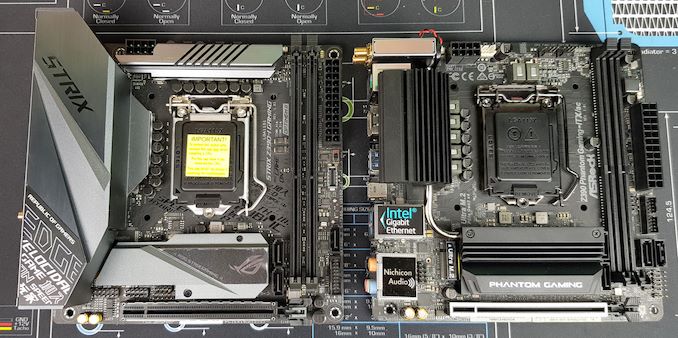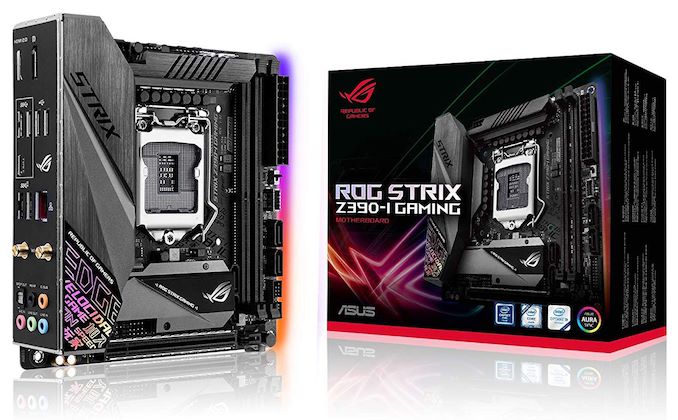Tiny at $200: ASUS Z390-I Gaming vs. ASRock Z390 Gaming-ITX/ac Review
by Gavin Bonshor on February 12, 2019 10:00 AM ESTThe Conclusion of Z390 Mini-ITX
Republic of Gamers Versus Phantom Gaming
The ASUS ROG Strix Z390-I currently retails for $194 at Newegg which positions it as the most expensive Z390 mini-ITX motherboard available. It has plenty of good quality features, but for the price point, the useful software suite included and solid firmware helps to back up the value factor. Normally a mini-ITX model with a solid feature set is usually a sure-fire winner, but it really does feel like something is missing to make it stand out from the competition.
It's really hard to justify the price difference over the slightly cheaper ASRock Z390 Phantom Gaming-ITX/ac which retails for $180 at present on Newegg. Another note to consider is that the ROG Strix Z390-I Gaming supports the double height double capacity 32 GB DDR4 modules from G.Skill and ZADAK which allows users to put 64 GB into such a small form factor; that's a highly impressive feat within its own right and for users wanting that combination will want to look towards the ROG model. But the ASRock motherboard has Thunderbolt 3, which is that extra feature that the other boards simply don't have.
ASUS ROG Strix Z390-I Gaming
The ROG Strix Z390-I Gaming is the sole mini-ITX offering from ASUS with a marketing focus on gaming. It's one of four Z390 Strix branded mid-range models and when compared to its ATX sized siblings, the Strix Z390-I Gaming is essentially a cut-down version of the ROG Strix Z390-F; the differences being form factor (mini-ITX versus ATX), half the memory slots and fewer PCIe slots available which is a consequence of being small form factor.
With the grandeur that comes with being a premium model, the Strix Z390-I Gaming has plenty of features which aren't just suitable for gaming, but for enthusiasts too. These include a SupremeFX S1220A HD audio codec which is assisted by the Sonic Studio III software which offers lots of customization and quality. The storage capabilities also offer plenty for the form factor with two M.2 slots (one front, one rear) included and one with a heatsink that doubles up to cool the Z390 chipset also. A total of four SATA ports with straight angled connectors are present with support for RAID 0, 1, 5 and 10 arrays.
On the design front, ASUS drops a gimmicky plastic rear panel cover and integrates one that's full metal and mills it directly into the power delivery heatsink design which is simply brilliant. Touching on the power delivery itself, ASUS has unscrupulously advertised the CPU Vcore to be running in a 6-phase configuration, but upon further inspection, it seems as though it's operating with three sets of two which would technically mean a 3-phase; ASUS hasn't used doublers to achieve this. The setup wasn't actually that bad however, as it excelled in our testing.
Throughout our testing, this board proved very competent and competitive with its overclocking potential. With Z390, ASUS has brought a great new feature to the table with the Ai Optimized Cooler Predictor. With this users can rely on the board's firmware to work out what overclock is possible using the installed cooling; a panel with a set of expected frequencies at defined voltages are displayed and users can simply enter them manually to achieve them. Our testing proved that with our test bed, the predicted settings worked without issue and the AI Optimized profile managed to achieve 5.0 GHz with 1.35 V on the CPU VCore. In our test suite, good performance was shown to prove consistent and the ROG Strix Z390-I Gaming managed to achieve the quickest booting times in our UEFI POST time test.
ASRock Z390 Phantom Gaming-ITX/ac
The ASRock Z390 Phantom Gaming-ITX/ac represents its high-end gaming-centric small form factor option. With the Z390 Phantom Gaming-ITX/ac, one of the key features is that Thunderbolt 3 port. We also get integrated RGB LEDs, RGB expandability, and use of a Realtek ALC1220 HD audio codec.
Much of the appeal comes from its overall attention to detail on the power delivery with a solid 5+2 design centered around an Intersil ISL69138 7-channel PWM controller. The Intersil ISL99227 60 A power stages are some of the best around and it seems ASRock is looking to appeal to more than just gamers with a lot of extreme options and profiles within the Phantom Gaming firmware. Motherboards with two memory slots are very favorable for performance at higher frequencies and are something extreme overclockers tend to look for in a motherboard.
The overclocking performance solidifies the quality of the power delivery as we achieved an overclock on our Core i7-8700K of 5.0 GHz at 1.35 V. It's clear that the Z390 Phantom Gaming-ITX/ac is targeted at gamers and enthusiasts alike. Performance in our test suite showed persistently good performance with no abnormalities. The small form factor Z390 Phantom Gaming board recorded good POST times and good overall DPC latency.













26 Comments
View All Comments
IKonev - Wednesday, February 13, 2019 - link
Re: TB3 comments, it evidently runs up to a max of half of the rate bandwidth (so, 20GB/s) using only 2 PCIe 3.0 lanes as opposed to the regular 4 lanes - here's what Tweaktown had to say:"Thunderbolt 3 is from the Intel JHL6240 Thunderbolt 3 controller; it's a low power 1.2W single port part that connects to the chipset through two PCI-E 3.0 lanes."
And yes, TB3 ports can effectively be used as USB ports, but the transfer speeds will max out at that of the cable & device plugged into the port.
romrunning - Wednesday, February 13, 2019 - link
Thanks for the helpful info! Maybe this review can be updated with that info.Dug - Wednesday, February 13, 2019 - link
I can't wait for motherboard reviews that go into what the motherboard actually does besides gaming benchmarks.I do like the power and boot times included, but really things like thunderbolt, usb, wifi, sound, memory, and storage (both sata and m.2) should all be tested. This is what makes or breaks a motherboard.
timecop1818 - Wednesday, February 13, 2019 - link
Also interesting to know what chipset handles HDMI2 conversion. Intel CPUs only support DisplayPort...hanselltc - Thursday, February 14, 2019 - link
asrock all day. that plastic shroud is soooooooooo ugly, and asrock has hratsinks instead.niemi - Wednesday, February 20, 2019 - link
Gavin, which program do you use to measure DPC latency?Is it idle or load numbers, and for how long do you run the test?
Any chance of a ‘highest measured’ or a curve over time as a supplement to the median? That would help when comparing for spikes.